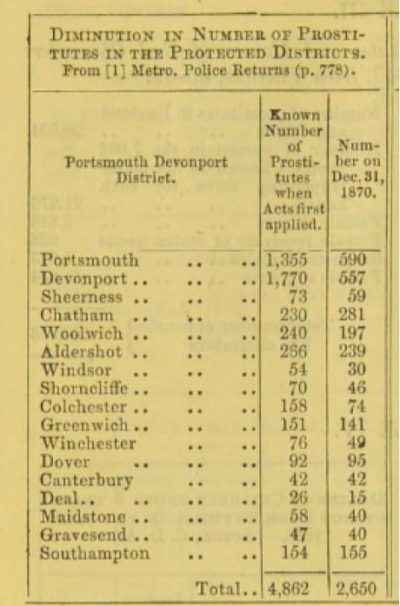Contagious Diseases Acts
1864
The Contagious Disease Act was initially was passed in 1864 with the aim of preventing venereal diseases within the armed forces. This legislation meant that police officers could arrest women suspected of being common prostitutes who they also suspected of being diseased. The women were then forced to undergo a medical examination and if they were found to be infected, they were confined for up to three months, in a Lock Hospital, until they were recovered. Initially, though this Act was only in force in Chatham, Devonport and Portsmouth areas with a radius of five miles.
1866
In 1866 the act was reformed and the new Contagious Disease Act of 1866, spread its jurisdiction to more naval ports, districts, and army towns and even the civilian population—with a new aim of regulating prostitution. This meant that every known prostitute was periodically examined whether she was suspected of being diseased or not and if infected the women could then be held, for a year in a lock hospital.
1869
The act was again reformed in 1869 with more towns added including Deal. The radius was also extended to ten miles and women not fit to be examined could also be held for up to five days.
Once in hospital, the act provided the women with food, clothing and a bed, with moral and religious instruction and, if required they were taught to read and write as well as given ‘other useful work”. Once cured, and if she so wished, she could be sent home. All this at the government’s expense. They could also be offered a place in a refuge and respectable employment.
1886
On the surface, this all sounded as if this was an act of care and kindness towards the women but many did not agree. The National Association for the Repeal of the Contagious Diseases Acts, which originally actually restricted women from joining, a fact that led to the formation of the Ladies National Association for the Repeal of the Contagious Diseases Acts, both these organisations campaigned for several years for the Act’s repeal. They felt it legalised the “sin” of prostitution, that it put the women under police and medical control and that the poorer women were often badly treated. That the act also highlighted the double standards of the day where men, who were just as responsible for the spreading of sexual diseases, were not subjected to the same medical examinations or indeed prevented from visiting the women in the first place.
The repeal of the act finally came in 1886.
Deal & Walmer
Through reading newspaper reports, while researching the Orrick family, we found that Mary Jane Orrick was subjected to a medical examination under the Contagious Diseases Act 1866-9. Maybe she, and her fellow Defendants, are included in these tables dated 1869-1870.


